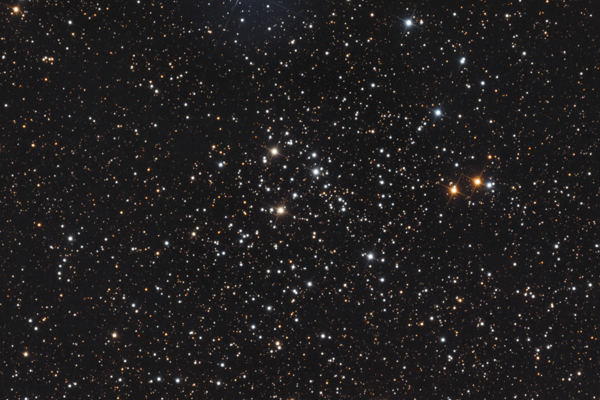NGC 129 and Riddle 4 in Cassiopeia
October 2022 - Nebula and Cluster of the Month
This month, we’ll look at two open clusters; one obvious, the other a little less so. We’ll start with one discovered by our old friend William Herschel. On 16th December 1788, he swept up a cluster in Cassiopeia that he described as A coarsely scattered cluster of large stars mixed with smaller ones, not very rich
. He entered it into his eighth class – coarsely scattered clusters of stars – as no. 79. It was included in John Herschel’s Slough Observations as JH 23 and in the General Catalogue as GC 63. In 1888 it entered the New General Catalogue as NGC 129. Its description in the NGC reads Cluster, very large, pretty rich, little compressed, stars 9 – 13
.

This large, obvious cluster lies almost exactly halfway between β and γ Cas, and with an integrated magnitude of 6.5 is a fairly easy binocular target. Estimates of its angular size vary from 12’ (Archinal & Hynes) to 21’ (Night Sky Observer’s Guide, Deep-Sky Field Guide). Visually speaking, a diameter of 12’ is a much better fit than 21’. The figure quoted for the number of member stars varies considerably too, from 35 (Deep-Sky Field Guide) to an optimistic 193 (Archinal & Hynes). Visually, again, the number looks to be 40–50 stars.
The brightest star, at the centre, is a variable star designated DL Cas. It is a δ Cepheid variable with a range of 8.63–9.26 in an interesting period of eight days and 58 seconds. Confusingly, Archinal & Hynes give the magnitude of the brightest star as 11.0.
Estimates of distances to the cluster are equally vague. Archinal & Hynes quote a very precise 1589 pc (almost 5200 light-years). In 1992, Turner et al1 determined the distance to be 1670±13 pc (5447±42 light-years), whereas Gieren et al2 in 1994, using the standard-candle Cepheid calculation on DL Cas, obtained a distance of 2034±110 pc (6633±359 light-years). What we can say with some certainty is that NGC 129 lies beyond the Orion Spur in which the Sun resides, and is seen against the background of the Perseus Arm, though it isn’t far enough away to lie within that arm of the galaxy.
Through the eyepiece, three bright stars in a triangle define the centre of the cluster, and all of these are within an arc made up of the brightest stars in the cluster. Many other fainter stars can be seen. I have made observations of this cluster on two occasions, separated by three years. My notes match the historical descriptions pretty well – well detached, little central concentration and a moderate range of stars. The Trumpler classification I derived from this was III2m, which is matched in the sources I have to hand.

The second cluster I’m going to discuss this month is a much smaller and fainter object. It is again located in Cassiopeia, but for once was not spotted by the great visual observers of old. That’s not a huge surprise. Riddle 4 doesn’t seem to be plotted on any star atlas (I don’t have Millennium, maybe somebody could check that for me). It’s not listed in any source I have, except the slightly obscure Optically Visible Open Clusters Catalogue. Even in that, I can only find two clusters with Riddle designations: Riddle 4 and Riddle 15.
Riddle 4 lies amongst the great mass of open clusters that define the Milky Way as it passes through Cassiopeia, though compared to its nearest neighbours, Stock 2 (almost a degree in diameter) and NGC 734 (just 6’ in diameter), it’s a real tiddler. It is a tiny curl of stars 30 or 40” in diameter. That’s about the same apparent diameter as Jupiter.
Its distance has been determined by Bisht et al3 as 2.8&plusmin;0.2 kpc (approximately 9000 light-years) and its age at 40&plusmin;10 million years. The distance likely places it within the Perseus Arm of the galaxy.
I observed this little cluster with my 12” (300mm) reflector at varying magnifications. The drawing was made at x300, a 12’ field. My notes read Absolutely tiny. 6 or possibly 7 stars of magnitude 13.5 – 14.7
.

| Object | RA | Dec | Type | Magnitude |
|---|---|---|---|---|
| NGC 129 | 00h 30’ 00” | +60° 12’ 43” | Open Cluster | 6.5 |
| Riddle 4 | 02h 07’ 11” | +60° 13’ 51” | Open Cluster | Br* = 13.0 |
References:
- ‘Galactic Clusters with Associated Cepheid Variables II – NGC 129 and DL Cassiopeiae’: Astronomical Journal 104(3): 1132-1143.
- ‘Independent distance determinations to Milky Way Cepheids in open clusters and associations. 1. The binary Cepheid DL Cas in NGC 129’: Astronomical Journal 107(6): 2093-2100.
- ‘Photometric study of open star clusters in II quadrant: Teutsch 1 and Riddle 4’: New Astronomy 42, July 2015.